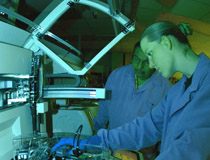Biorefinery
Organisation de la formation
 Training
Training
The first semester is dedicated to theoretical courses:
- Biomass production and recycling
- Bio and chemical processes
- Biomass pretreatment and thermal treatment
- Chemicals and fuels from biomass
- English
- Transferable skills (GRH, project management, bibliographic project)
The second semester focuses on a research project which can be carried out in academic or industrial laboratories, or in one of the partner universities' laboratories (Univ. of Thessaloniki in Greece, Univ. of Bari in Italy).
 Coordination de la formation
Coordination de la formation
Les enseignements théoriques et pratiques du M2 sont rassemblés sur le premier semestre et sont suivis d’un stage de 6 mois. Le programme comprend sept modules :
- Biomass production and recycling
- Bio and chemical processes
- Biomass pretreatment and thermal treatment
- Chemicals and fuels from biomass
- English
- Transferable skills (GRH, project management, bibliographic project, …)
- Research project
Le stage de 6 mois peut s’effectuer dans un des laboratoires d’accueil universitaire, dans une entreprise de spécialité chimique ou dans un des laboratoires des universités partenaires (Thessalonique (Grèce), Bari (Italie), …).
| Sem. | Intitulé/Présentation des unités d'enseignements | Crédits |
|---|---|---|
| S3 | ||
|
BioRef1 - Plant Biomass production and valorisation
Pré-requis : Basic structure of the main biomolecules (polysaccharides, lipids, proteins, nucleic acids). - Main techniques used in analytical chemistry (HPLC, GC, MS, NMR, spectroscopy) - Good level in English
Volume horaire : 50h lecture Responsable : Simon Hawkins
- Present the different kinds of land and marine plants that can be used in a biorefinery. - Describe the opportunities and difficulties of working with biological material - Describe the contribution of plant biomass in a bioeconomy - Present the different types of biorefinary and land products.
Knowledge: - on the range of different land and marine plants that can be used in biorefinary Competences : After the UE, the student is sensed to be capable to : - Identify a bioeconomic model and provide arguments to (in)validate it Determine the kind of ad-hoc biorefinery needed for a specific land depending on the potential bio ressources present or arable. - Identify suitable strategies for evaluating biomass quality Programme Introduction to the diversity of plant biomass. The module will present several examples of industrial products/resources obtained from plants. Examples will include the use of ligno-celluloses, starch, oils and proteins from both land and marine plants for the production of energy and materials. The opportunities and difficulties of working with biological material (diversity, variability, production, harvesting, extraction etc.) will be discussed, as well as the choice of appropriate analytical techniques for evaluating biomass quality. The contribution of plant biomass to a bioeconomy and the different types of biorefinery and line products will be presented. |
5 | |
|
BioRef2 - Bio and chemical processes
Pré-requis : - mass and heat balances - reaction kinetics - Knowledge about protein structures and functions
Volume horaire : 40h lecture Responsable : Benjamin Katryniok
- Identify the function of a catalytic reactor – difference between ideal and real reactor - Model the function of a heterogeneous catalytic reactor - Optimize a heterogeneous catalytic reactor for a given objective
Knowledge : - Difference between ideal and non-ideal reactors Competences : After the UE, the student is sensed to be capable to : - Identify and model the hydrodynamic behavior of a non-ideal reactor - Implementation of enzyme in reactors for biomass treatment for bio-molecule and chemicals production. Programme Chemical Reactors I - Introduction to reactor modeling (M. Araque-Marin) - Introduction (isothermal reactors, types of reactions (reversible and irreversible) - Mass balance for ideal reactors (definition of conversion and residence time distribution: stirred tank reactor and plug flow reactor) - Relationship between volume and conversion for CSTR and PFR (isolated reactors, cascade of reactors) - Parallel reactions in CSTR and PFR (reactions of same and different reaction order) - Consecutive reactions in CSTR and PFR Chemical Reactors II - Non-ideal catalytic reactors (B. Katryniok) - residence time distribution, modelling (cascade and axial dispersion model) - Mass transfer limitations (internal / intragranular and external limitations) and their impact on the catalytic performance (conversion, selectivity, deterioration of kinetic data) and on economics - Heat transfer limitations (internal and external) and their impact on the catalytic performance (efficiency, hot-spot formation, light-off, safety and thermal runaway) - Pressure drop and the balance between mass transfer limitations including economical impacts - Examples: Micro-reactors, fluidized-bed reactors, trickle-bed reactors Bioreactors (R. Froidevaux, D. Le Couturier, P. Jacques) - Biomass treatment with enzymes in reactor for biomolecule and chemicals production: examples of non-continuous and continuous reactors (batch, CSTR, PBR) Unit operations specific to biomass treatment (L. Nikov, D. Krasimir, L. Firdaous, M. Aresta) Extraction of oils from oleaginous seeds; Oil characterization; Conversion of lipids into FAMEs; The Free Acid issue;Hydrolysis; Catalysts for the simultaneous transesterification of lipids and esterification of FFAs; Conversion of polyenes into mono-enes. Conversion of C6-C5 into furan derivatives. |
5 | |
|
BioRef3 - Biomass pretreatment and thermal treatment
Pré-requis : - mass and heat balances - reaction kinetics
Volume horaire : 50h lectures Responsable : Mirella Virginie
- To explore the feasibility of thermal pretreatment of biomass
Knowledge : - Basic knowledge in heterogeneous catalysis. - Basic knowledge of the biomass obtained in the "biomass" module in the first year. - Bases in inorganic chemistry, materials chemistry and physical chemistry acquired in license - Good level of English Competences After the UE, the student is sensed to have knowledge about : - Pretreatments applied to the cellulosic biomass to its transformation Programme Cellulosic biomass pretreatment: Hydrolyze, fermentation, chemical treatment (G. Agrimi, L. Palmeri) I - Molecular structure of biomass - cellulosic - Hemicellulose -Lignin II - Physical, Chemical and Biological pretreatment of biomass - Hydrolysis - Enzymatic Hydrolysis. - Enzyme discovery III - Fermentation to Bioethanol - Process configuration IV - Case studies
Lignin pretreatment: Radical and chemical pretreatments (K. Vigier de Oliveira, F. Jerome, C. Crestini) I - Description of the lignin - structure - variability with the source of lignin - What can we do with lignin?
II - Chemical pretreatments of lignin - lignoboost process - organosolv process - Alkalin treatment - AFEX process (effect on lignin) - oxidation III - Physical treatment, ball milling IV - Lignin biosynthesis V – Advanced methods in lignin analysis - 31P-NMR, - 2D-NMR - quantitative 2D-NMR - GPC VI - Hydrothermal treatments VII - Kraft process VIII - structural characterization of technical lignins IX - Lignin fractionation methods X - Lignin upgrade
Algae fractionation : to proteins, sugars, lipids, fine chemicals (M. Aresta) I - Introduction to aquatic biomass - macroalgae - microlagae - plants II - Composition of algae Main classes of compounds: lipids, proteins, carbohydrates, other chemicals III - Cultivation of algae Dependence of the composition on the cultivation technology IV - Harvesting of algae Technologies and energy consumption V - Fractionation technologies VI - The lipidic fraction composition Dependence on the strain used and the cultivation technology VII - Energy (biofuels) from algae and perspective exploitation - FAMEs - biodiesel - bioalcohols - biohydrogen - biomethane VIII - Economics of algae growing for energy production Is energy from algae economically viable?
Gasification of biomass - Syngas production and valorization (V. Ordomskiy, A. Khodakov) I - Biomass gasification - Theory of gasification Types of gasifies, zones in gasification, chemistry of gasification, properties of producer gas - Characteristics of biomass for gasification Energy content and density, moisture content, dust and tar content - Gasification systems Fixed bed gasifiers, fluidized bed gasifiers, entrained flow gasifiers, plasma gasifiers II - Biosyngas upgrading Biosyngas composition III - Biosyngas transformation Methane production IV - Examples of biomass gasification ongoing technologies (Rentech, Gussing gasifier, EON-SNG, UCG process etc… )
Biogas from waste, residual biomass, environmental issues (M. Virginie) I - Biogas composition - Dependence from feedstock composition - Dependence from production process II - Biogas for energy uses - Biogas for heat production - Biogas to cogeneration systems - Biogas into natural gas grid - Biogas as vehicle fuel III - Biogas upgrading - Adsorption - Water scrubbing - Physical adsorption - Chemical adsorption - Membrane technology IV - Biogas cleaning - Hydrogen sulfide removal - Water removal - Siloxanes removal - Oxygen removal - Nitrogen removal - Ammonia removal |
5 | |
|
BioRef4 - Chemicals and fuels from biomass
Pré-requis : Students wishing to take this training must have a good background in catalysis and must be aware of the most usual reactions (and of the main moieties of interest) in organic chemistry, together with having a broad basic knowledge of the main current techniques used in spectrochemistry. The multidisciplinary nature of the topic addressed in the lectures also requires a good general culture and a spirit of curiosity that is not limited to chemistry but also touches on all scientific disciplines.
Volume horaire : 80h lectures Responsable : Franck Dumeignil
Develop skills in catalysts synthesis (chemical complexes of transition metals, supported, colloids,...), in catalytic reaction for biomass transformation through homogeneous, heterogeneous and enzymatic catalysis.
Knowledge : - Have knowledge of major industrial processes involving homogeneous and heterogeneous catalysis for the conversion of biomass. Competences : The student acquires a scientific approach in the implementation of enzymatic catalysis for transformation and valorization of biomass for biomolecule and chemical production. This concerns a future engineer or researcher, and is valid for any industry in biotechnology, both public and private. Programme Homogeneous catalysis for cellulosic and oily biomass conversion o Principles of homogeneous catalysis, organometallic mainly (metals, ligands, key steps), acid / base catalysis, Lewis / Brønsted; notions of recycling
Heterogeneous catalysis for cellulosic and oily biomass conversion o Principles of heterogeneous catalysis What is catalysis ? o Transformation of polyols in liquid and gas phases Gas-phase and liquid phase dehydration of glycerol to acrolein and upgrading of the latter to high value-added chemicals (acrylonitrile, acrylic acid). o Acetalization reaction of light alcohol. o Guerbet reaction (alcohols) o Transformation of sugar (fructose, saccharose, …) o H2 production from bio-based compounds. o Principle of high-throughput experiments Development of HTE for catalysis
Biotechnologies for biomass conversion (algae, cellulose, etc.) o Principles of enzymatic catalysis in homogeneous and heterogeneous mode o Metabolic engineering of microorganisms: Strain engineering and development o Metabolic engineering of microorganisms: Metabolic flux analysis o Biomass gasification o Biotechnologies for biodiesel production o Biochemicals from Biomass Enzymatic transesterification of oily biomass Enzymatic conversion for chemicals production from biomass |
10 | |
|
BioRef5 - English
Pré-requis : B2-level
Volume horaire : 48 Responsable : Frédéric Damageux Programme - Academic English: how to differentiate between spoken English and formal English, and use the appropriate terms and expressions in a formal essay/letter/thesis - Presentation English: how to give good, clear and concise PP Presentation. How to prepare it, express yourself clearly, address your audience, react to questions, etc. - CVs and covering letters: how to write a modern, clear, attractive CV well adapted to your goals. How to write a covering letter that will stand out and emphasise your qualities in good, accurate English - Lab English: how to describe lab experiments (including materials, equipment, set up, conclusions) with audio exercises providing examples in international context - Part of the course is also specifically aimed at students who need to improve their proficiency, with vocabulary and grammar exercises, audio and video documents, and interaction. |
5 | |
| S4 | ||
|
Lab research -
Responsable :
Mickaël Capron
Be able to manage a clear research topic and provide a structured report of the work, evidencing results, problems, potential solutions,…
Knowledges : application of the acquired knowledges Competences : After the UE, the student is sensed to be capable to : - Manage a bibliography research - Implement experiments Programme Bibliography research Experimental work Report writting Oral presentation of the results |
25 |

